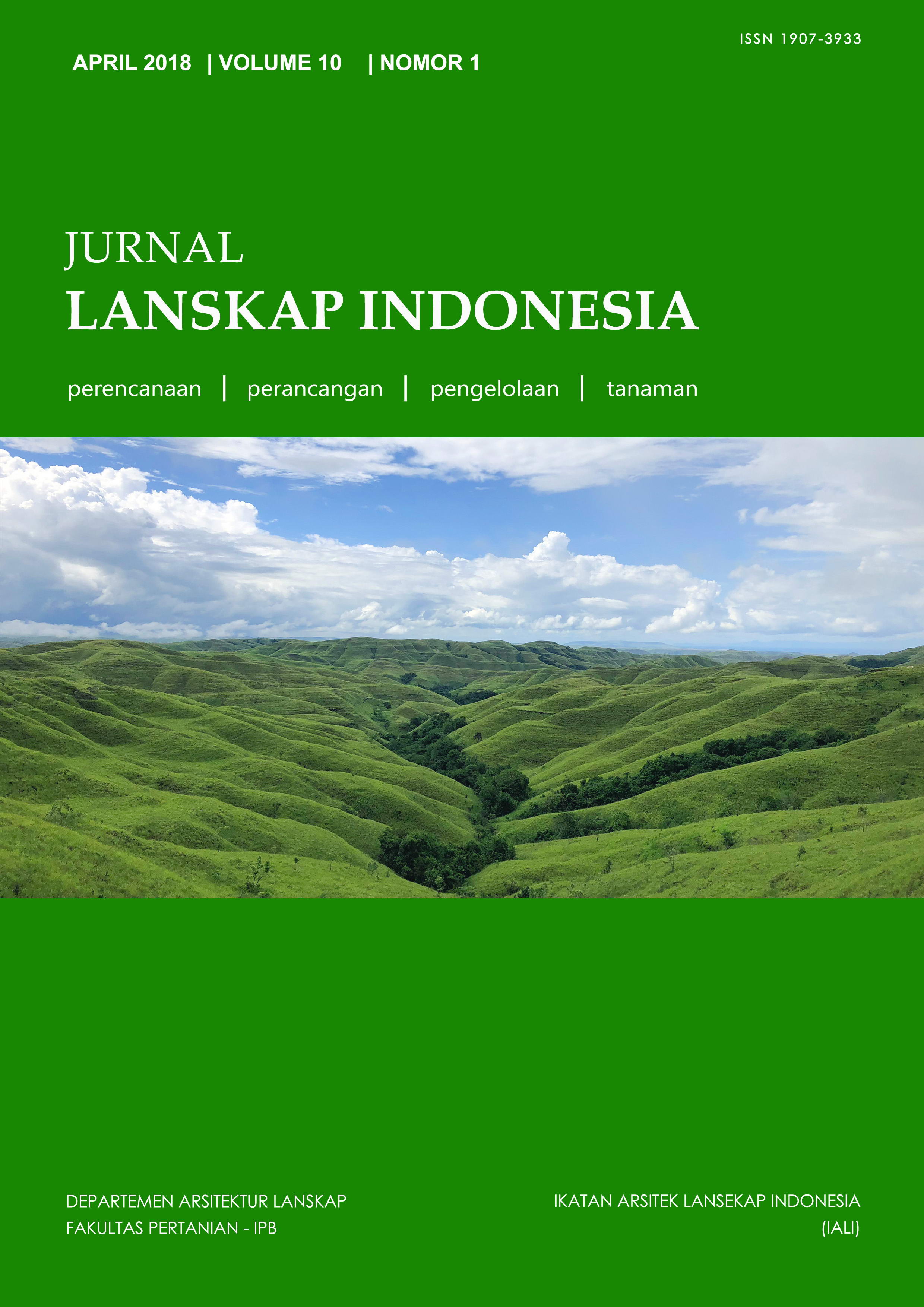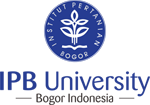EFEKTIVITAS RUANG TERBUKA HIJAU SEBAGAI HABITAT BURUNG DI KOTA BOGOR DAN SEKITARNYA
Abstract
Green open spaces can be potential habitats for birds in urban landscapes. Due to high number of land development, the green open spaces in urban landscapes tend to be small and scattered. Indeed, analysis about effectivity of green open spaces as bird habitats in Bogor City and its surroundings is needed. We investigated bird habitat patches on 14 locations in Bogor City and its surroundings. This study aimed to analyze the effectiveness of bird habitat patches for bird species richness using two variables (size and complexity). The data were analyzed using the Pearson Correlation and multiple linear regression. The results showed that there were no significant differences between bird species richness and size of patches. Conversely, there were significant differences between bird species richness and complexity of patches. The Pearson Correlation revealed that there were high correlation between bird species richness and complexity of patches. Finally, we propose three recommendations of green open spaces as bird habitat patches in Bogor City and its surroundings, such as protecting and managing both small and large bird habitat patches, increasing number of vegetation strata and number of vegetation in some strata in small bird habitat patches, and increasing number of vegetation in some strata in large bird habitat patch with low bird speciess richness.Downloads
References
August, P.V. 1983. The Role of Habitat Complexity and Heterogeneity in Structuring Tropical Mammal Communities. Ecology. 64(6)1495-1507.
Beck, T. 2013. Principles of Ecological Landscape Design. Washington: Island Pr.
Bibby, C.J. 2004. Bird Diversity Survey Methods. Di dalam: Sutherland, W.J., Newton, I., Green, R.E. 2004. Bird Ecology and Conservation: A Handbook of Techniques. New York: Oxford Univ Pr. Hal: 1-15.
Bullock, J.M. 2006. Plants. Di dalam: Sutherland, W.J. 2006. Ecological Census Techniques. 2nd ed. Cambridge: Cambridge Univ. Hal: 186-213.
[CABE] Commission for Architecture and the Built Environment. 2009. Open Space Strategies: Best Practice Guide. London: CABE.
Carbó-Ramírez, P., Zuria, I. 2011. The Value of Small Urban Greenspaces for Birds in a Mexican City. Landscape and Urban Planning. 100(2011):213-222.
Chiesura, A. 2004. The Role of Urban Parks for the Sustainable City. Landscape and Urban Planning. 68(1):129-138.
Diamond, J.M., Bishop, K.D., Van Balen, S. 1987. Bird Survival in an Isolated Javan Woodland: Island or Mirror?. Conservation Biology. 1(4):132-142.
Donnelly, R., Marzluff, J.M. 2006. Relative Importance of Habitat Quantity, Structure, and Spatial Pattern to Birds in Urbanizing Environment. Urban Ecosystem. 9(2006):99-117.
Dramstad, W.E., James, D.O., Forman, R.T.T. 1996. Landscape Ecology Principles in Landscape Architecture and Land-Use Planning. Washington: Island Pr.
Dyke, F.V. 2003. Conservation Biology: Foundations, Concepts, Applications. New York: McGraw-Hill Companies, Inc.
Endah, G.P.,Partasasmita, R. 2015. Keanekaan Jenis Burung di Taman Kota Bandung, Jawa Barat. Prosiding Seminar Nasional Masyarakat Biodiversitas Indonesia. 6(1):1289-1294.
Fontana, S., Sattler, T., Bontadina, F., Moretti, M. 2011. How to Manage the Urban Green to Improve Bird Diversity and Community. Landscape and Urban Planning. 101(2011):278-285.
Forman, R.T.T., Godron, M. 1986. Landscape Ecology. New York: John Wiley and Sons.
Furness, R.W., Greenwood, J.J.D., Jarvis, P.J. 1993. Birds as Monitors of Environmental Change. Furness, R.W., Greenwood, J.J.D., editor. London: Chapman & Hall.
Irwan, Z.D. 2012. Prinsip-prinsip Ekologi: Ekologi, Lingkungan, dan Pelestariannya. Jakarta: Bumi Aksara.
Kim, J., Chae, J., Koo, T.H. 2007. Variation in Bird Diversity in Relation to Habitat Size in the Urban Landscape of Seoul, South Korea. Acta Ornithologica. 42(1):39-44.
Koskimies, P. 1989. Birds as A Tool in Environmental Monitoring. Annales Zoologici Fennici. 26(1989):153-166.
Lee, Y.C., Kim, K.H. 2015. Attitudes of Citizens towards Urban Parks and Green Open Spaces for Urban Sustainability: The Case of Gyeongsan City, Republic of Korea. Sustainability. 7(7):8240-8254.
[LIPI] Lembaga Ilmu Pengetahuan Indonesia. 2013. 3500 Plant Species of The Botanic Gardens of Indonesia. Jakarta: LIPI.
MacGregor-Fors, I., Schondube, J.E. 2011. Gray vs Green Urbanization: Relative Importance of Urban Features for Urban Bird Communities. Basic and Applied Ecology. 12(2011):372-381.
Murphy, S., Legge, S., Heinsohn, R. 2003. The Breeding Biology of Palm Cockatoos (Probosciger aterrimus): A Case of a Slow Life History. Zoology. 261(2003):327-339.
Nichol, J.E., Wong, M.S., Corlett, R., Nichol, D.W. 2010. Assessing Avian Habitat Fragmentation in Urban Areas of Hongkong (Kowloon) at High Spatial Resolution using Spectral Unmixing. Landscape and Urban Planning. 95(2010):54-60.
Nilon, C.H., Berkowitz, A.R., Hollweg, K.S. 2003. Understanding Urban Ecosystems: A New Frontier for Science and Education. New York: Springer-Verlag New York, Inc.
Ontario, J., Hernowo, J.B., Haryanto, Ekarelawan. 1991. Pola Pembinaan Habitat Burung di Kawasan Pemukiman Terutama di Perkotaan. Bogor: Jurusan Konservasi Sumberdaya Hutan, Fakultas Kehutanan, Institut Pertanian Bogor.
Paker, Y., Yom-Tov, Y., Alon-Mozes, T., Barnea, A. 2014. The Effect of Plant Richness and Urban Garden Structure on Bird Speciess Richness, Diversity, and Community Structure. Landscape and Urban Planning. 122(2014):186-195.
Parsons, H. 2007. Best Practice Guidelines for Enhancing Urban Bird Habitat. Birds in Backyards Program. New South Wales.
Robertson, P.A., Liley, D. 1998. Assessment of Sites: Measurement of Species Richness and Diversity. Di dalam: Bibby, C., Jones, M., Marsden, S. 1998. Expedition Field Techniques: Bird Surveys. London: Expedition Advisory Centre. Hal: 80-102.
Setiawan, A., Alikodra, H.S., Gunawan, A., Darnaedi, D. 2006. Keanekaragaman Jenis Pohon dan Burung di Beberapa Hutan Kota Bandar Lampung. Jurnal Manajemen Hutan Tropika. 12(1):1-13.
Simonds, J.O., Starke, B.W. 2006. Landscape Architecture: A Manual of Environmental Planning and Design. 4th ed. New York: McGraw-Hill Companies, Inc.
Sukara, G.N., Mulyani, Y.A., Muntasib, E.K.S.H. 2014. Potensi untuk Pengembangan Wisata “Birdwatching” di Pusat Konservasi Tumbuhan Kebun Raya Bogor. Buletin Kebun Raya. 17(1):44-56.
Sukmantoro, W., Irham, M., Novarino, W., Hasudungan, F., Kemp, N., Muchtar, M. 2007. Daftar Burung Indonesia No.2. Bogor: Indonesian Ornitologists Union.
Strohbach, M.W., Lerman, S.B., Warren, P.S. 2013. Are Small Greening Areas Enhancing Bird Diversity? Insights from Community-driven Greening Projects in Boston. Landscape and Urban Planning. 114(2013):69-79.
This journal permits and encourages authors to post items submitted to the journal on personal websites or institutional repositories both prior to and after publication, while providing bibliographic details that credit, if applicable, its publication in this journal. However, after the article is submitted and published in this journal, it is fully copyrighted by the Jurnal Lanskap Indonesia or JLI. If excerpts from other copyrighted works are included, the author must obtain written permission from the copyright owner and give credit to the source in the article. Then, the writer or reader is allowed to copy, share, and redistribute articles/material in any form. But it must still include the appropriate source and credit because the article in this journal is licensed by Creative Commons Attribution 4.0 International License (CC BY 4.0).
I. Proposed Policy for Journals That Offer Open Access
Authors who publish with this journal agree to the following terms:
- Authors retain copyright and grant the journal right of first publication with the work simultaneously licensed under a Creative Commons Attribution License that allows others to share the work with an acknowledgement of the work's authorship and initial publication in this journal.
- Authors are able to enter into separate, additional contractual arrangements for the non-exclusive distribution of the journal's published version of the work (e.g., post it to an institutional repository or publish it in a book), with an acknowledgement of its initial publication in this journal.
- Authors are permitted and encouraged to post their work online (e.g., in institutional repositories or on their website) prior to and during the submission process, as it can lead to productive exchanges, as well as earlier and greater citation of published work (See The Effect of Open Access).
II. Proposed Policy for Journals That Offer Delayed Open Access
Authors who publish with this journal agree to the following terms:
- Authors retain copyright and grant the journal right of first publication, with the work after publication simultaneously licensed under a Creative Commons Attribution License that allows others to share the work with an acknowledgement of the work's authorship and initial publication in this journal.
- Authors are able to enter into separate, additional contractual arrangements for the non-exclusive distribution of the journal's published version of the work (e.g., post it to an institutional repository or publish it in a book), with an acknowledgement of its initial publication in this journal.
- Authors are permitted and encouraged to post their work online (e.g., in institutional repositories or on their website) prior to and during the submission process, as it can lead to productive exchanges, as well as earlier and greater citation of published work (See The Effect of Open Access).



























